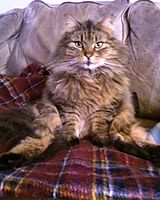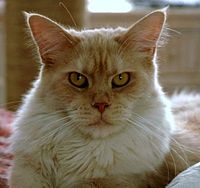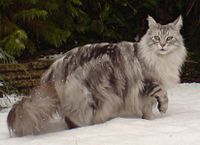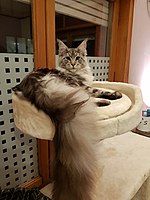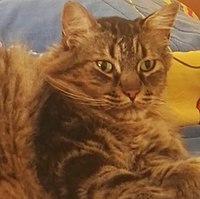Maine Coon
| Maine Coon | |
|---|---|
 A Maine Coon in the snow | |
| Other names | Coon Cat Maine Cat Maine Shag American Longhair[1] American Coon Cat American Forest Cat[2] |
| Common nicknames | Gentle giants |
| Origin | |
| Breed standards | |
| CFA | standard |
| FIFe | standard |
| TICA | standard |
| ACF | standard |
| ACFA/CAA | standard |
| CCA-AFC | standard |
| GCCF | standard |
| Domestic cat (Felis catus) | |
The Maine Coon is the largest domesticated cat breed. It has a distinctive physical appearance and valuable hunting skills. It is one of the oldest natural breeds in North America, specifically native to the US state of Maine,[3] where it is the official state cat.
No records of the Maine Coons exact origins and date of introduction to the United States exist, so several competing hypotheses have been suggested, the most credible suggestion being that it is closely related to the Norwegian Forest cat and the Siberian. The breed was popular in cat shows in the late 19th century, but its existence became threatened when long-haired breeds from overseas were introduced in the early 20th century. The Maine Coon has since made a comeback and is now one of the most popular cat breeds in the United States.
The Maine Coon is a large and sociable cat, hence its nickname, "the gentle giant". It is characterised by a prominent ruff along its chest, robust bone structure, rectangular body shape, an uneven two-layered coat with longer guard hairs over a silky satin undercoat, and a long, bushy tail. The breed's colors vary widely, with only lilac and chocolate disallowed for pedigree. Reputed for its intelligence and playful, gentle personality, the Maine Coon is often cited as having "dog-like" characteristics.[4][5] Professionals notice certain health problems recurring in the breed, including feline hypertrophy cardiomyopathy and hip dysplasia, but reputable breeders use modern screening methods to minimise the frequency of these problems.
A Maine Coon Polydactyl is a Maine Coon polydactyl cat. This variation is acceptable within general judging standards for the breed, and is even separately certified by some organisations like TICA.[6]
History
The Maine Coon is the largest domesticated cat breed. It has a distinctive physical appearance and valuable hunting skills. The breed was popular in cat shows in the late 19th century, but its existence became threatened when long-haired breeds from overseas were introduced in the early 20th century.
Origin
The ancestral origins of the Maine Coon are unknown[7]—there are only speculation and folk tales. One story involves Marie Antoinette, the Queen of France who was executed in 1793. The story goes that before her death, Antoinette attempted to escape France with the help of Captain Samuel Clough. She loaded Clough's ship with her most prized possessions, including six of her favourite Turkish Angora (or possibly Siberian) cats. Although she did not make it to the United States, all of her pets managed to reach the shore of Wiscasset, Maine safely, where they bred with other short-haired breeds and developed into the modern breed of the Maine Coon.[8]
Cat shows and popularity


The first mention of Maine Coon cats in a literary work was in 1861, in Frances Simpson's The Book of the Cat (1903). F.R. Pierce, who owned several Maine Coons, wrote a chapter about the breed.[9] During the late 1860s, farmers located in Maine told stories about their cats and held the "Maine State Champion Coon Cat" contest at the local Skowhegan Fair.[10]
In 1895, a dozen Maine Coons were entered into a show in Boston. On 8 May 1895, the first North American cat show was hosted at Madison Square Garden in New York City. A female Maine Coon brown tabby, named Cosey, was entered into the show. Owned by Mrs. Fred Brown, Cosey won the silver collar and medal and was named Best in Show.[11] The silver collar was purchased by the Cat Fanciers' Association (CFA) Foundation with the help of a donation from the National Capital Cat Show. The collar is housed at the CFA Central Office in the Jean Baker Rose Memorial Library.[10]
In the early 20th century, the Maine Coon's popularity began to decline with the introduction of other long-haired breeds, such as the Persian, which originated in the Middle East. The last recorded win by a Maine Coon in a national cat show for over 40 years was in 1911 at a show in Portland, Oregon. The breed was rarely seen after that. The decline was so severe that the breed was declared extinct in the 1950s, although this declaration was considered to be exaggerated and reported prematurely at the time. The Central Maine Cat Club (CMCC) was created in the early 1950s by Ethylin Whittemore, Alta Smith and Ruby Dyer in an attempt to increase the popularity of the Maine Coon. For 11 years, the CMCC held cat shows and hosted exhibitions of photographs of the breed and is noted for creating the first written breed standards for the Maine Coon.[10]
The Maine Coon was denied provisional breed status—one of the three steps required for a breed not yet recognised by the CFA to be able to compete in championship competitions[12]—by the CFA three times, which led to the formation of the Maine Coon Cat Club in 1973. The breed was finally accepted by the CFA under provisional status on 1 May 1975, and was approved for championship status on 1 May 1976. The next couple of decades saw a rise in popularity of the Maine Coon, with championship victories and an increase in national rankings. In 1985, the state of Maine announced that the breed would be named the official state cat.[13] Today the Maine Coon is the third most popular cat breed, according to the number of kittens registered with the CFA.[14]
Description
The Maine Coon is a large and sociable cat, hence its nickname, "the gentle giant". It is characterized by a prominent ruff along its chest, robust bone structure, rectangular body shape, an uneven two-layered coat with longer guard hairs over a silky satin undercoat, and a long, bushy tail.
Markings
The Maine Coon is a long- or medium-haired cat. The coat is soft and silky, although texture may vary with coat colour. The length is shorter on the head and shoulders and longer on the stomach and flanks, with some cats having a lion-like ruff around their neck. Minimal grooming is required for the breed compared to other long-haired breeds, as their coat is mostly self-maintaining owing to a light-density undercoat. The coat is subject to seasonal variation,[15] with the fur being thicker in the winter and thinner during the summer.
Maine Coons can have any colours that other cats have. Colours indicating crossbreeding, such as chocolate, lavender, the Siamese pointed patterns or the "ticked" patterns, are not accepted by some breed standards (the ticked pattern, for example, is accepted by TICA and CFA).[10] The most common pattern seen in the breed is brown tabby.[16] All eye colours are accepted under breed standards, with the exception of blue or odd-eyes (i.e. heterochromia iridium, or two eyes of different colours) in cats possessing coat colours other than white.[15]
Habits

Maine Coons have several physical adaptations for survival in harsh winter climates. Their dense water-resistant fur is longer and shaggier on their underside and rear for extra protection when they are walking or sitting on top of wet surfaces of snow or ice.[17] Their long and bushy raccoon-like tail is resistant to sinking in snow, and can be curled around their face and shoulders for warmth and protection from wind and blowing snow. It can even be curled around their backside like an insulated seat cushion when sitting down on a frozen surface.[18] Large paws, and especially the extra-large paws of polydactyl Maine Coons,[19] facilitate walking on snow and are often compared to snowshoes.[17] Long tufts of fur growing between their toes help keep the toes warm and further aid walking on snow by giving the paws additional structure without significant extra weight.[18] Heavily furred ears with extra long tufts of fur growing from inside can keep warm more easily.[17]
Personality
Maine Coons are known as the "gentle giants"[5] and possess above-average intelligence, making them relatively easy to train.[4] They are known for being loyal to their family and cautious—but not mean—around strangers, but are independent and not clingy. The Maine Coon is generally not known for being a "lap cat", but their gentle disposition makes the breed relaxed around dogs, other cats, and children. They are playful throughout their lives, with males tending to be more clownish and females generally possessing more dignity, yet both are equally affectionate.[17] Many Maine Coons have a fascination with water and some speculate that this personality trait comes from their ancestors, who were aboard ships for much of their lives.[7] Maine Coons are also well known for being very vocal cats. They are known for their frequent yowling or howling, trilling, chirping, and making other loud vocalisations.[20]
Size
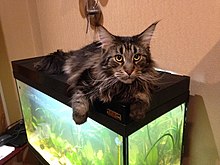
The Maine Coon was considered the largest breed of domestic cat, until the introduction of the Savannah Cat in the mid 1980s. On average, males weigh from 13 to 18 lb (5.9 to 8.2 kg), with females weighing from 8 to 12 lb (3.6 to 5.4 kg).[21] The height of adults can vary between 10 and 16 in (25 and 41 cm) and they can reach a length of up to 38 in (97 cm), including the tail, which can reach a length of 14 in (36 cm)[22] and is long, tapering, and heavily furred, almost resembling a raccoon's tail. The body is solid and muscular, which is necessary for supporting their weight, and the chest is broad. Maine Coons possess a rectangular body shape and are slow to physically mature; their full size is normally not reached until they are three to five years old, while other cats take about one year.[23]
In 2010, the Guinness World Records accepted a male purebred Maine Coon named "Stewie" as the "Longest Cat", measuring 48.5 in (123 cm) from the tip of his nose to the tip of his tail. Stewie died 4 February 2013, from cancer at his home in Reno, Nevada, at age 8.[24][25] As of 2015 the living record-holder for "Longest Cat" is "Ludo", measuring 3 ft 10.59 in (118.33 cm). He lives in Wakefield, UK.[26] In May 2018 the Maine Coon "Barivel" measured 120 cm (3 ft 11.2 in), making him the current holder of the Guinness World Records. This was verified on 22 May 2018 by Guinness Book Of World Records.[27] Large Maine Coons can overlap in length with Eurasian lynxes, although with a much lighter build and lower height.[28]
-
A sitting Maine Coon
-
Female Maine Coon brown tabby, age 6.
-
A Maine Coon kitten at 3 days old
-
Cream shaded Maine Coon
-
Maine Coon silver tabby
-
Maine Coon kitten at 75 days old
-
Black Silver Tabby 7 months old male Maine Coon
-
A Peruvian Maine Coon
-
17 year old male Maine Coon
-
Orange Tabby Maine Coon (Aged 13)
-
John Perry Barlow's Maine Coon Buck
Diet
Maine Coons do not need a special diet. They are naturally big cats that are high energy, almost kitten-like throughout their entire life. All that energy requires quality food to fuel it.[29]
Health
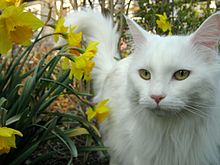
Pet insurance data obtained from a study during years 2003–2006 in Sweden puts the median lifespan of the Maine Coon at > 12.5 years. 74% lived to 10 years or more and 54% lived to 12.5 years or more.[30] Maine Coons are generally a healthy and hardy breed that is adapted to survive the challenging climate of New England. The most severe threat is feline hypertrophic cardiomyopathy (HCM), the most common heart disease seen in cats, whether purebred or not. In Maine Coons, it is thought to be inherited as an autosomal dominant trait. Middle-aged to older cats and males are thought to be predisposed to the disease.[31] HCM is a progressive disease and can result in heart failure, paralysis of the hind legs due to clot embolization originating in the heart, and sudden death.[32]
A specific mutation that causes HCM is seen in Maine Coons for which testing services are offered.[33] Of all the Maine Coons tested for the MyBPC mutation at the Veterinary Cardiac Genetics Lab at the College of Veterinary Medicine at Washington State University, approximately one-third tested positive.[34] Not all cats that test positive will have clinical signs of the disease, and some Maine Coon cats with clinical evidence of hypertrophic cardiomyopathy test negative for this mutation, strongly suggesting that a second mutation exists in the breed. The HCM prevalence was found to be 10.1% (95% CI 5.8 -14.3% ) in this study.[35] Early growth and nutrition, larger body size, and obesity may be environmental modifiers of genetic predisposition to HCM.[36]
Another potential health problem is spinal muscular atrophy (SMA), another genetically inherited disease which causes the loss of the spinal-cord neurons which activate the skeletal muscles of the trunk and limbs. Symptoms are normally seen within 3–4 months of age and result in muscle atrophy, muscle weakness, and a shortened lifespan. A test is offered to detect the genes responsible for SMA.[37]
Hip dysplasia is an abnormality of the hip joint which can cause crippling lameness and arthritis. The cats most commonly affected with hip dysplasia tend to be males of the larger, big-boned breeds such as Persians and Maine Coons. The relatively smaller size and weight of cats frequently results in symptoms that are less pronounced.[38] X-rays submitted to the Orthopedic Foundation for Animals (OFA) between 1974 and 2011 indicates that 24.3% of Maine Coons in the database were dysplastic. The Maine Coon is the only cat breed listed in the database.[39] The hip dysplasia registry (public and private) collected by OFA through April 2015 also showed that there were 2,732 cats that suffered from hip dysplasia, of which 2,708 (99.1%) were Maine Coons.[40] Dysplasia was more severe in bilateral than unilateral cases and with increasing age.
Polycystic kidney disease (PKD) is an inherited condition in cats that causes multiple cysts (pockets of fluid) to form in the kidneys. These cysts are present from birth. Initially they are very small, but they grow larger over time and may eventually disrupt kidney function, resulting in kidney failure. While renal cysts are observed with a low incidence in Maine Coons, PKD appears to be a misnomer in this particular breed. In a recent study[41] spanning 8 years, renal cysts were documented by ultrasound in 7 of 187 healthy Maine Coons enrolled in a pre-breeding screening programme. The cysts were mostly single and unilateral (6/7, 85.7%) small (mean 3.6 mm in diameter) and located at corticomedullary junction (4/6, 66.7%), thus different in size, number, and location from those observed in Persian-related breeds. In the same study, not only did all six Maine Coon cats with renal cysts test negative for the PKD1 mutation, proving the disease in these cats to be unrelated to the PKD observed in Persians and related breeds, but gene sequencing of these cats failed to demonstrate any common genetic sequences. 'Maine Coon PKD' thus appears to represent a form of juvenile nephropathy other than AD-PKD.[42]

Many of the original Maine Coon cats that inhabited the New England area possessed a trait known as polydactylism (having one or more extra toes on a paw).[17] Polydactylism is rarely, if ever, seen in Maine Coons in the show ring, since it is not allowed by competition standards.[43] The gene for polydactylism is a simple autosomal dominant gene,[44] which has shown to pose no threat to the cat's health.[45] Polydactyly in Maine Coon cats is characterised by broad phenotypic diversity. Polydactyly not only affects digit number and conformation, but also carpus and tarsus conformation.[46] The trait was almost eradicated from the breed due to the fact that it was an automatic disqualifier in show rings.[47] Private organizations and breeders were created in order to preserve polydactylism in Maine Coon cats.
See also
References
- ^ Morris, Desmond (10 May 1999). Cat breeds of the world: A complete illustrated encyclopedia. Viking. p. 90. Retrieved 28 June 2012.
- ^ "Maine Coon Cats". Animal-World.
- ^ "Breed information". Maine Coon Breeders & Fanciers Association. Retrieved 26 October 2008.
- ^ a b Robins, Sandy. "Training Day". Popular Cats Series. 2. Bow Tie Magazines: 118–125.
- ^ a b "Maine Coon Synopsis". American Cat Fanciers Association. Retrieved 26 October 2008.
- ^ "Maine Coon Polydactyl Breeders". tica.org. Retrieved 16 February 2020.
- ^ a b Helgren, J. Anne. "Maine Coon". Iams. Telemark Productions. Archived from the original on 19 November 2008. Retrieved 26 October 2008.
- ^ "History, Legends and Myths of the Maine Coon". Maine Coon Rescue. Archived from the original on 5 December 2008. Retrieved 26 October 2008.
- ^ Simpson, Frances (1903). Chapter 28: Maine Cats (PDF). Cassell & Company, Limited. pp. 325–331. Retrieved 27 October 2008. The Book of the Cat
- ^ a b c d Frew, Gail. "Breed Article: America's First Show Cat – The Maine Coon Cat". Cat Fanciers' Association. Archived from the original on 6 June 2012. Retrieved 20 April 2012.
- ^ "Maine Coon Cat Article". Cat Fanciers' Association. Retrieved 30 August 2018.
- ^ "Cat Breed Directory: New or Experimental Breeds". Animal Planet. Discovery Communications. Retrieved 15 January 2009.
- ^ "Title 1, § 217: State Cat". Maine State Legislature. Retrieved 7 December 2008.
The state cat shall be the Maine Coon cat.
- ^ "The Cat Fanciers' Association announces most popular cats!" (PDF). Retrieved 15 May 2013.
- ^ a b "The ACFA Maine Coon Standard". American Cat Fanciers Association. Archived from the original on 23 September 2008. Retrieved 2 November 2008.
- ^ "Choosing a Maine Coon". PetPlace.com. Intelligent Content Corp. Retrieved 2 November 2008.
- ^ a b c d e "The Maine Coon: Cat Breed FAQ". Cat Fanciers. 2003. Retrieved 2 November 2008.
- ^ a b "The origin of the Maine Coon". PawPeds.com. The Scratch Sheet. 1976. Retrieved 15 December 2008.
- ^ "Part III". PawPeds.com. The origin of the Maine Coon. The Scratch Sheet. 1976. Retrieved 8 January 2009.
- ^ "Maine Coon Cat Behaviour and Characteristics". Maine-coon-cat-nation.com.
- ^ Mattern, Joanne; Pedley, Carol A. (2000). The Maine Coon Cat. Minnesota: Capstone Press. p. 4. ISBN 0-7368-0565-6.
- ^ "Maine Coon: A gentle giant" (PDF). Royal Canin. Archived from the original (PDF) on 23 July 2011. Retrieved 31 October 2008.
- ^ "Maine Coon cat" (PDF). Cat Fanciers Federation. Archived from the original (PDF) on 29 December 2009. Retrieved 25 October 2009.
- ^ "World's longest cat dies in Nevada". CBS News. Retrieved 6 February 2013.
- ^ Valois, Erin (20 October 2010). "World's longest cat revealed (and other notable animal world records)". National Post.
- ^ "Longest domestic cat (living)". Guinness World Records. Retrieved 21 June 2017.
- ^ "Maine Coon Awarded 2018 Guinness Book of World Records, longest domestic cat".
{{cite web}}:|archive-date=requires|archive-url=(help) - ^ Nowak, Ronald M. (1999). Walker's Mammals of the World. Vol. 2. Johns Hopkins University Press. p. 831. ISBN 0-8018-5789-9.
- ^ "Do Maine Coons Need a Special Diet?". MaineCoon.org. Retrieved 15 March 2016.
- ^ Egenvall, A.; Nødtvedt, A.; Häggström, J.; Ström Holst, B.; Möller, L.; Bonnett, B. N. (2009). "Mortality of life-insured Swedish cats during 1999–2006: Age, breed, sex, and diagnosis". Journal of Veterinary Internal Medicine. 23 (6): 1175–1183. doi:10.1111/j.1939-1676.2009.0396.x. PMC 7167180. PMID 19780926.
- ^ Gould, Alex; Thomas, Alison (2004). Breed Predispositions to Diseases in Dogs and Cats. Ames, Iowa: Blackwell Publishing. ISBN 1-4051-0748-0.[page needed]
- ^ Gompf, Rebecca; Kittleson, Mark; Little, Susan. "Feline Hypertrophic Cardiomyopathy". Cat Fanciers' Association. Archived from the original on 13 May 2008. Retrieved 24 November 2008.
- ^ "Hypertrophic Cardiomyopathy Genetic Mutation Testing Service for Cats". Washington State University. Archived from the original on 15 October 2008. Retrieved 20 November 2008.
- ^ "Frequently Asked Questions about the test for the Hypertrophic Cardiomyopathy Mutation". Washington State University. Archived from the original on 26 September 2008. Retrieved 21 November 2008.
- ^ "Myosin-Binding Protein C DNA Variants in Domestic Cats (A31P, A74T, R820W) and their Association with Hypertrophic Cardiomyopathy" (PDF). vetogene.it.
- ^ Freeman, Lisa M; Rush, John E; Meurs, Kathryn M; Bulmer, Barret J; Cunningham, Suzanne M (21 September 2012). "Body size and metabolic differences in Maine Coon cats with and without hypertrophic cardiomyopathy". Journal of Feline Medicine and Surgery. 15 (2): 74–80. doi:10.1177/1098612x12460847. ISSN 1098-612X. PMC 5971105. PMID 23001953.
- ^ "MCBFA Health Information & References". Maine Coon Breeders & Fanciers Association. Retrieved 20 November 2008.
- ^ Cat Owner's Home Veterinary Handbook (3rd ed.). John Wiley and Sons. 2007. p. 359. ISBN 978-0-470-09530-0.
- ^ "Hip Dysplasia Statistics". Orthopedic Foundation for Animals. Archived from the original on 20 February 2012. Retrieved 21 January 2018.
- ^ Loder, Randall T.; Todhunter, Rory J. (21 April 2017). "Demographics of hip dysplasia in the Maine Coon cat". Journal of Feline Medicine and Surgery. 20 (4): 302–307. doi:10.1177/1098612x17705554. hdl:1805/17463. ISSN 1098-612X. PMID 28430011. S2CID 4355779.
- ^ Gendron, K.; Owczarek-Lipska, M.; Lang, J.; Leeb, T. (2013). "Maine Coon renal screening: ultrasonographical characterisation and preliminary genetic analysis for common genes in cats with renal cysts". Journal of Feline Medicine and Surgery. 15 (12): 1079–85. doi:10.1177/1098612X13492164. PMID 23735675. S2CID 43268867.
- ^ Gendron, Karine; Owczarek-Lipska, Marta; Lang, Johann; Leeb, Tosso (December 2013). "Maine Coon renal screening: ultrasonographical characterisation and preliminary genetic analysis for common genes in cats with renal cysts". Journal of Feline Medicine and Surgery. 15 (12): 1079–1085. doi:10.1177/1098612X13492164. ISSN 1098-612X. PMID 23735675. S2CID 43268867.
- ^ King, Lucinda. "So what happened to the Maine coon polydactyl?". Maine Coon Polydactyl International. Retrieved 2 November 2008.
- ^ Grindell, Susan. "Polydactyl summary". Maine Coon Polydactyl International. Retrieved 2 November 2008.
- ^ Grindell, Susan. "The effects of polydactyly". Maine Coon Polydactyl International. Retrieved 2 November 2008.
- ^ Hamelin, Alexia; Begon, Dominique; Conchou, Fabrice; Fusellier, Marion; Abitbol, Marie (April 2017). "Clinical characterisation of polydactyly in Maine Coon cats". Journal of Feline Medicine and Surgery. 19 (4): 382–393. doi:10.1177/1098612X16628920. ISSN 1098-612X. PMID 26862149. S2CID 34145481.
- ^ Grindell, Susan. "Incidence [of polydactyly] in the original breed population and today". Maine Coon Polydactyl International. Retrieved 2 November 2008.
Further reading
- Bass, Sharyn P. (1983). This Is the Maine Coon Cat. Neptune City, New Jersey: T.F.H. Publications. ISBN 0-87666-867-8.
- Hayman, Tracey K. (2001). Maine Coon Cat. Dorking, England: Interpret Publishing. ISBN 1-84286-011-9.
- Hornidge, Marilis (2002). That Yankee Cat: The Maine Coon. Gardiner, Maine: Tilbury House. ISBN 0-88448-243-X.

